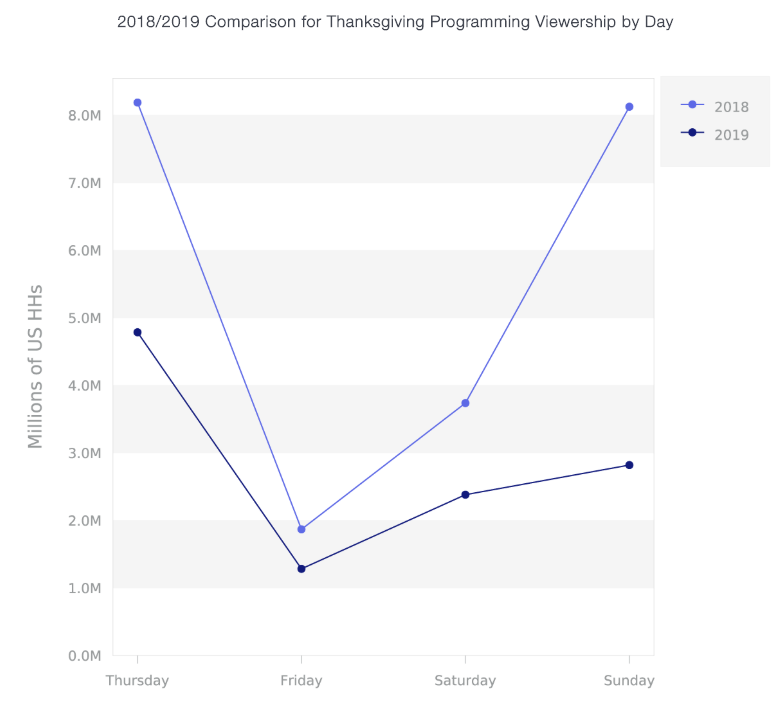Two recent reports paint a grim picture for the future of linear television as the streaming evolution sweeps across the consumer content landscape.
Magna Global’s 2020 forecast for television advertising predicts a 5% decline in overall spending — the steepest drop in over a decade. The silver lining is that it still predicts overall spending will increase as dollars flow away from linear television and into new formats, such as streaming and podcasting. While the top line data may be positive, the overall theme of the report is clear: Advertisers are beginning the long-anticipated march away from linear television to meet consumers where many of them now spend the bulk of their TV-watching time.
As if to make the point more clearly, Samba TV, a provider of connected TV analytics that has code on more than 25 million smart televisions globally, reported astounding figures for live television consumption during the Thanksgiving holiday this year: Thanksgiving Day saw a 41% decline in total live TV viewers from 2018. Black Friday and Saturday were also down by a third. The bottom completely fell out on Sunday, with a 65% decrease in viewership compared to 2018.

June 5th: The AI Audit in NYC
Join us next week in NYC to engage with top executive leaders, delving into strategies for auditing AI models to ensure fairness, optimal performance, and ethical compliance across diverse organizations. Secure your attendance for this exclusive invite-only event.
These trends point to the evolutionary shift underway in how television consumption, and by extension advertising, will occur in the very near future. Figures from Statista indicate that six out of 10 adults in the U.S. now stream, and they stream a lot, watching twice as many hours of content each day via a streaming service as they do via live television. OpenX reports that 42% of consumers have either cut the cord or plan to this year.
When comparing the Thanksgiving data referenced in the Samba TV study with recent surveys from The Harris Poll on holiday shopping intent, we see a clear correlation, with 30% of all holiday shoppers reporting they watched zero live television.
These macro-market changes present real challenges to marketers who still target 90% or more of their video budgets at linear channels, even as tens of millions of their core consumers abandon the programming.
Just as the Magna numbers showed overall growth still driving the global advertising market forward, there are clear winners in the television advertising space.
Two key races will determine who benefits most from the migration of tens of billions of dollars away from linear channels to time-shifted and streaming content: the platform race and the content race. Here’s how they stack up as of today.
Platform players
On the platform side, companies like Roku (and to a lesser extent Amazon) are well-positioned to benefit from the platforms they have built that enable consumers to access streaming content while companies hone the advertising chops needed to monetize not only their content, but the content of their application partners.
Roku sells ad space for the hundreds of apps on its platform and takes a revenue share of the ad sales. The success of the ad sales business has helped Roku’s platform business, which includes advertising, grow 80% in Q3 while also driving up the average revenue per user by a third.
Amazon has a similar revenue share model in place for subscriptions sold through Amazon prime. The company also has a robust advertising business brewing on Twitch, the video game streaming channel watched by millions of gamers every day that is now 100% ad supported. While Amazon Prime Video is really more of a “nice to have” for Bezos and company, helping make Prime membership “stickier” overall, I believe the potential OTT advertising revenue could reach into the multiple billions in the not too distant future.
The long-term direct benefit to Roku is also clear. As new streaming players enter the market, they will need a platform to surface their content. These content providers will have to advertise within the Roku ecosystem to promote their streaming channels and attract viewers, and many will ultimately opt to have Roku manage the sale of ads within their content. It’s a win-win for Roku, with strong revenue network effects for its business.
Content competition
On the content side, providers like Hulu and Pluto TV have read the market and are well-positioned to tap into the ad-supported streaming content model. According to a 2019 survey of more than 2,000 streamers, most consumers prefer an ad-supported model option that either lowers the cost of streaming or eliminates it entirely. In fact, 70% of Hulu users choose the ad-supported model. Embracing the reality that consumers want choice (some ads sometimes, no ads other times) helps companies position themselves to benefit from the streaming evolution. Those without an ad-supported option, like Netflix, will feel increased pressure to adopt one to remain competitive.
What is also interesting about the content players is the innovation they’re bringing to what has largely been a stale industry (TV advertising). Hulu, for example, has looked closely at the usage patterns of its subscribers and recognized that they hit the pause button 30 million times a day. That creates a natural, non-intrusive opportunity for a new kind of ad format. The “pause ads” on Hulu drove a 68% increase in overall ad recall, providing a better ad experience for the user and better return on investment (ROI) for the marketer.
Data gold rush
An unfolding side race is all about data, and it’s perhaps the most interesting and underreported consideration. Surprisingly, in 2019 marketers still buy television much the same way they have for the past 40 years: using antiquated Nielsen set-top data from a few thousand households in an attempt to extrapolate the usage patterns of more than 300 million consumers across the most fragmented media landscape in history. The old model simply does not work any longer, and marketers are reacting — as evidenced by the decline in TV ad budgets.
New data companies are emerging to challenge and innovate the TV buying model so that advertisers can use the same level of rich data and insight marketers have come to expect from their digital buys. The depth and breadth of knowledge now available from connected televisions into what, how, and when consumers actually watch programs is already beginning to drive far greater marketer ROI. The improved connected TV advertising experience will continue to shift more ad dollars into the streaming environment, if for no other reason than the fact that these ads simply perform better for marketers. Companies that develop the technologies to capture new insights, targeting, and analytical capabilities will be well-positioned to take advantage of the streaming ad gold rush.
Viewers win
A final important insight is that consumers will be the undisputed winners of these shifts. The early days of streaming advertising engagement have been, in a word, awful. Ads that repeat four, five, or six times per hour were common in the early days. As advertisers abandon traditional television and compete more aggressively for streaming attention, advertising diversity will flourish, just as new data capabilities will enable better insights and relevancy targeting.
Consumers will receive a far more relevant advertising experience in the streaming and smart TV world than is capable today on linear television. This will enable content creators and platforms to sell less advertising at a higher price. Hulu, for example, is currently selling about half the ad load of traditional television per hour because of its ability to leverage data and relevancy in new and innovative ways.
Streaming is eating linear television — of that there can be no doubt. But all is not lost in ad land. Fewer overall ads, better ROI, and a more relevant advertising experience for the consumer are in store as the next evolution of TV advertising kicks into high gear.
Dallas Lawrence is an advisor to Channel Factory and the former chief communications and brand officer for OpenX.

